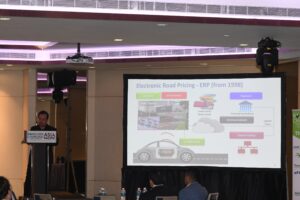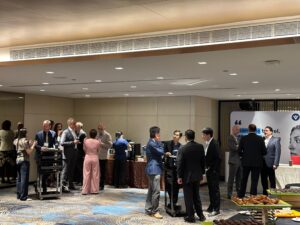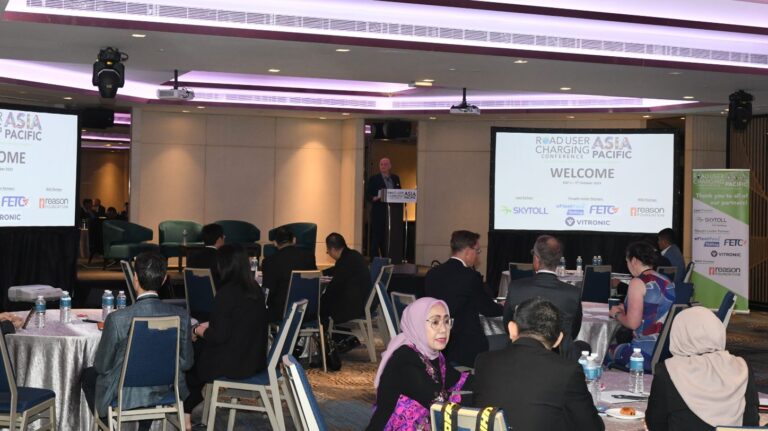Key highlights from the inaugural Road User Charging Conference Asia Pacific, which took place on the 05-06 October 2023 at the Four Points by Sheraton Riverview Hotel in Singapore…
Following in the footsteps of its Brussels and Miami-based counterparts, the latest edition in Akabo Media’s Road User Charging Conference series – Road User Charging Conference Asia Pacific – highlighted the latest tolling technologies, road-user charging (RUC) projects and intelligent transport systems being implemented across the Asia-Pacific region.
With more than half of the world’s population living in the region, the Asia Pacific constitutes a diverse mix of fast emerging and developed economies that collectively account for a large, connected road network enabling the flow of people and goods – which presents a host of complex challenges and exciting opportunities for senior decision-makers responsible for operating and maintaining the transportation infrastructure in this incredibly important part of the world.
Thus, Road User Charging Conference Asia Pacific 2023 brought together senior transportation professionals from leading public-sector organisations and private-sector businesses based in some 20 countries across the region to share best practices, ideas, and information on how to better regulate traffic and generate revenues on highways and major arterial roads in and out of the region’s most congested cities.
A bespoke agenda tailored specifically to countries within the Asia-Pacific region provided insight into a variety of charging models including time- and distance-based charging, congestion charging, emission-based charging and all-electronic tolling.

For example, Victor Shu, deputy director of Singapore’s Land Transport Authority’s Nexgen ERP Taskforce, discussed the host state’s ongoing shift toward a new satellite-based road pricing system. Likewise, Walter Edgar Theseira, associate professor of economics at Singapore University of Social Sciences, offered up analysis of the economic and political challenges Singapore is striving to overcome in order to implement one of the largest, most sophisticated urban road pricing systems in the world.
As delegates learned, while congestion pricing is an efficient solution to road congestion, its implementation in many cities has been stalled by politics. As such, policymakers in Singapore have negotiated underlying aspirations for private car ownership and usage in a rapidly growing and increasingly affluent population.
Daizong Liu, East Asia director at the Institute for Transportation & Development Policy, based in China, revealed why Chinese cities have yet to successfully implement congestion pricing despite rising traffic levels. According to Liu, China’s most congested city, Beijing, began preparations for the introduction of congestion pricing in 2015 by establishing six working groups focused on policy and regulations, technical infrastructure, pricing and fees, information and communication, enforcement and oversight, and revenue management.
However, Liu explained that the primary argument against the introduction of congestion pricing in Beijing was that people believed the concept doesn’t alleviate traffic congestion but rather restricts the driving privileges of the less affluent, thereby exacerbating social inequality.
Thus, as of 2018, less than 20% of people in Beijing said they supported congestion charging. And due to this negative perception of congestion pricing, Beijing subsequently abandoned the idea in favour of parking fee reform.
Liu finished his presentation by providing an overview of some of the key lessons learned from Beijing’s congestion pricing failure. These included the need to win the support of vehicle owners, the need to make the benefits of congestion pricing more visible, especially in reviving public transportation, and attracting more supporters by offering direct discounts on transit fares within the charging zone.
Constituent parts
The programme also tackled a variety of crucial topics and issues that form different parts of the conversation around tolling and road-user charging (RUC), such as financing and procurement, enforcement and compliance, payment systems and options, rate setting policies and practices, interoperability, communication and PR, legislation and policy, data and privacy, equity, sustainability and decarbonisation.
The topic of equity in RUC was adeptly tackled by Adrian Moore, vice president of policy at US think tank, the Reason Foundation. During the session, Moore examined the issues with addressing equity within a RUC programme, the different levels of interaction between government and users, lessons learned about how RUC affects equity relative to prior revenue sources, and how different jurisdictions around the world have sought to address RUC equity issues.
“Any RUC programme raises questions and concerns about equity,” stated Moore. “Of particular concern is whether a shift from current means of collecting revenue to a RUC will create winners and losers. If so, then issues arise on how to address inequities within and around the RUC programme.”
The future of RUC in two close-neighbouring countries in the APAC region was also discussed. First, Marian Willberg, manager for demand management and revenue at New Zealand’s Ministry of Transport, explained New Zealand’s RUC system, including its advantages and disadvantages, and the challenges facing the funding of land transport in New Zealand, as well as the work being undertaken to explore how to fund land transport in the future.
“New Zealand has had RUC for its diesel and heavy vehicle fleet since 1978,” Wilberg told delegates. “This has provided a stable and gradually increasing level of revenue for the land transport system, alongside fuel taxes from petrol vehicles, as the population has grown and as vehicle kilometres travelled has generally increased.
“Conveniently, this system of RUC applies to electric vehicles, which will start paying in 2024. But the funding of land transport in New Zealand is now facing several challenges. Construction costs, more frequent climate events, and expenditure aspirations have increased transport expenditure.
“At the same time responding to climate change will add further and substantial investment, particularly in areas such as public transport. And if vehicle travel is successfully reduced there will be a plateauing or reduction of revenue from some major sources.
“The New Zealand Ministry of Transport is exploring how to pay and who should pay for the transport system in the future. This includes the role of fuel taxes and road user charges, congestion charging and other forms of pricing, and tolling.”

Senator Bridget McKenzie, Australia’s shadow minister for infrastructure, transport and regional development, then talked about the politics of introducing RUC in Australia. Her session covered why both state and federal Australian governments are encouraging the growth of EVs by resisting the introduction of RUC, why someone will eventually have to pay for the country’s vast road network and how policymakers are grappling with these challenges.
“Victoria, my home state, is the first state in Australia to introduce an electric vehicle road user charge. It is a brilliant example of how not to design such a scheme,” said McKenzie, who explained how she believes it represents an impediment to introducing a nationally consistent RUC.
“By acting alone, there is a genuine risk that over time there could be up to eight different RUC regimes in effect across the country, all with their specific quirks. The complexity for Australian families and freight companies of complying with eight different schemes would be a red tape nightmare.”
As delegates learned, the validity of Victoria’s scheme is being challenged in the High Court of Australia on constitutional grounds. “In simple terms, the case turns on whether a state government is lawfully able to impose such a RUC, or if that power rests solely with the Commonwealth,” explained McKenzie.
Tech talks
A number of presentations were delivered by some of the world’s leading device and equipment suppliers, technology companies and mobility service providers. As lead partner of the conference, SkyToll delivered two presentations. The first saw the company’s sales and solution consultant Joseph Chin explain how AI-powered electronic toll collection (ETC) could improve traffic congestion at toll plazas.
Chin’s session covered the integration of AI algorithms into front-end tolling equipment and back-office operations systems and outlined how AI could enhance operational processes and reduce overhead costs.
“Many toll operators are demanding a higher detection accuracy rate of passage vehicles travelling through the toll plazas, thereby reducing revenue leakage,” explained Chin. “AI-powered technology for multi-lane free flow [MLFF] tolling could significantly improve the detection accuracy rate, reduce human manual intervention for toll operations, ensure safety for all road users and, importantly, that the required level-of-service is achieved.”
The second SkyToll presentation saw Mária Mardzinová, manager for solutions innovations and architecture, discuss the role of interoperability in achieving barrier-free road-user charging and revenue growth.

Mardzinová explained why interoperability is a complex task that requires collaboration and coordination among multiple stakeholders; how interoperability allows for quicker passage through toll points, better traffic flow, fewer delays and lower emissions; and how interoperability can enhance usability and revenue collection for transportation infrastructure maintenance and development.
And despite conceding that achieving full interoperability can be challenging due to different tolling infrastructures, administrative systems, and legal frameworks across various regions or countries, Mardzinová rounded out her presentation by reassuring delegates how “efforts to establish interoperable RUC systems are reasonable as the benefits to both toll authorities and drivers are significant.”
The topic of AI-driven tolling was also revisited by Boris Wagner, BU TSE head and BU Traffic TSE sales at Vitronic, who drew upon a recent personal experience travelling from Italy to Austria to explain how the technology can be used to achieve a seamless transition from plaza to MLFF. Wagner also shared examples of best practice from Australia and Poland, showcased state-of-the-art performance and looked beyond tolling by exploring future applications.
More insight into MLFF tolling was also provided by Rizza B Latorre, vice president, business transportation office, Metro Pacific Tollways Corporation (MPTC). Latorre presented MPTC’s roadmap toward the implementation of MLFF tolling on concession toll roads in the Philippines – a first for the country as MPTC looks to replace the current traditional toll barrier/gate set up with a state-of-the-art MLFF solution.
“MPTC is building toward a barrier-free future to make every Filipino journey safe, comfortable and pleasurable,” said Latorre. “Customer-centric and forward-looking, MPTC is transforming its business to be responsive enough for the new demands of Filipino motorists.”
The topics of research analytics, trends, reports, users and security systems were expertly tackled by Leonardo De La Vega (founder and CEO) and Sabin Shrestha (technical programmer) of eFleetPass Tolling.
Drawing upon the complexities of quantum computing, Vega and Shrestha explained how the Australian company’s technology can solve toll leakage problems in operator networks; how eFleetPass’ suite of fleet business software applications can build and increase toll reputation; and pondered the future of in-vehicle tolling and mobility with on-demand payments and blockchain tolling.
Final thoughts
Over the course of the two days of the event, it became clear that a number of challenges and opportunities lay ahead for those involved in tolling and RUC across the Asia Pacific, including:
- Adoption of electronic systems: More countries are shifting from manual toll collection to electronic toll collection systems for efficiency and reduced traffic congestion.
- Public perception: There can be public resistance to tolls or charges, especially if the benefits (such as reduced congestion or improved infrastructure) aren’t immediately visible.
- Equity concerns: Policymakers have to ensure that tolls and charges don’t disproportionately affect certain socioeconomic groups.
- Technological advancements: The adoption of vehicle telematics and other technologies such as GNSS and AI can pave the way for more refined and dynamic road user charging systems in the future.
However, there’s no silver bullet or one-size-fits-all solution. While the Asia-Pacific region has seen a blend of traditional tolling, congestion pricing, and other RUC mechanisms, the specifics vary by country, and each nation has different needs.
Thus, what’s needed now is more education and cooperation among policymakers, technology providers and other stakeholders to ensure trends and methods continue to evolve in ways that, ultimately, benefit the user and utilise technology advancements to meet clear policy goals.
Road User Charing Conference Asia Pacific will return to Singapore in 2024! Click here for more information.





